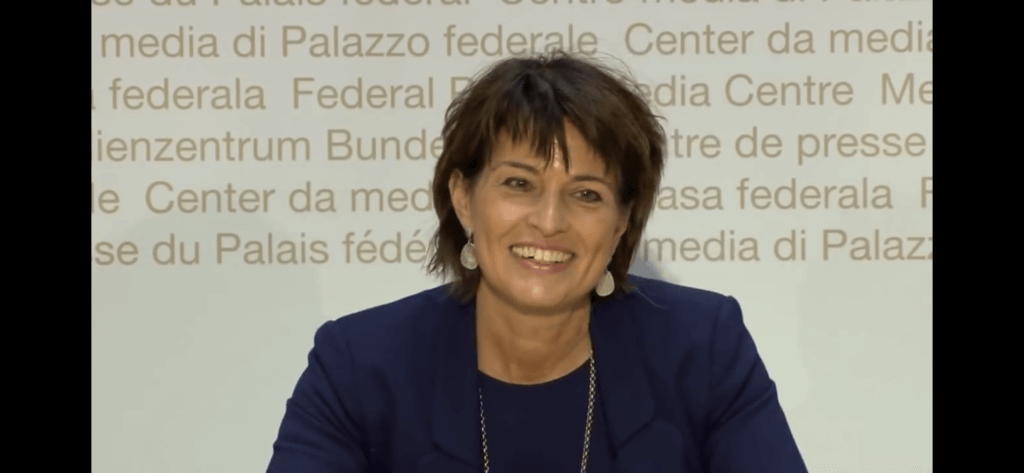
Former federal councillor Doris Leuthard has revealed details of her new project. It involves really big things for Switzerland.
Ms Leuthard gave details about her involvement with an association. As co-president of “Svizra27”, the ex-minister is campaigning for Switzerland’s next national exhibition.
“The work around the feasibility study is in full swing,” she said in the latest print edition of the “Schweizerische Gewerbezeitung“. The organization has a great drive, and she is very satisfied with the progress of the work, it continued.
Major event for Switzerland
The motto ‘People-Work-Cohesiom’ for the next national exhibition, which only takes place once every 25 years or so, would be just right, Leuthard added. “With the next national exhibition we can take Switzerland further,” she stressed.
But she did not yet want to comment on the financial aspects of ‘Svizra27‘. At the moment possible scenarios are being examined with regard to their feasibility. In the process, approaches to solutions are being analyzed, risks identified and prospects for success assessed, she said.
“In addition, an economic assessment of the project will be carried out as part of a business plan,” the former federal councillor explained.
“Switzerland can afford a next national exhibition; it must afford it,” Leuthard emphasized in her conviction.
Must the federal government pay?
However, the project must first reach a certain level of maturity, have in-depth clarifications and elaborate ideas, before politicians, as the largest donor, can deal with it, the co-president continued. “The Federal Council knows very well that from time to time such a project is needed to bind the country together,” Leuthard also stressed.
This time, the major project is most likely to be planned in north-western Switzerland, which is why business and trade associations from the five cantons of north-west Switzerland are particularly committed to the cause.
Snapshot of the epoch
According to information from the Swiss FDFA, the most recent national exhibition took place in 2002 in the lake region of Neuchâtel, Biel and Murten. On so-called ‘Arteplages,’ Expo.02 focused on the themes of openness and the environment. The national exhibition was spread over four different waterfront sites in Biel, Neuchâtel, Yverdon-les-Bains and Murten.
The major event is always held with the aim of presenting the country’s culture, politics and economy. This is as a kind of snapshot of the era. The first national exhibition was held in Zurich in 1883. Its central theme was the importance of schools and education as a growth factor for the economy.
Self-discovery of the country
The three following exhibitions (1896 in Geneva, 1914 in Bern and 1939 in Zurich) were characterized by the army and the desire to emphasize the country’s independence. The Landi 1939 in Zurich, in particular, was all about spiritual national defense.

Excerpt from a very early official advertising brochure for the Swiss National Exhibition in Zurich in 1939. (Image credit “Photobibliothek.ch”)
The 1964 national exhibition in Lausanne drew a futuristic picture of Switzerland with the Gulliver project: a computer continuously provided the latest status of a survey conducted among exhibition visitors on the major contemporary issues.
Millions of visitors
According to research by muula.ch, Swiss national exhibitions have always met with great public interest. This can be seen, for example, in the number of visitors. Nearly 2 million saw the first national exhibition in Zurich in 1883, and 12 million Expo 64 in Lausanne, according to a report on the subject by the Council of States’ Business Audit Committee (GPK-SR).
That great attention, however, was often accompanied by sharp criticism, which referred on the one hand to organizational deficiencies and to the design of individual inclusions of the exhibition.
profits and losses
According to the report, the funds spent on a national exhibition rose from 3.6 to 187 million Swiss francs between 1883 and 1964. The 1883 and 1914 exhibitions closed with modest profits of 23,000 and 34,000 Swiss francs, respectively, while the 1939 exhibition closed with a substantial surplus of 6.4 million Swiss francs.
The 1896 exhibition showed a deficit of 270,000 Swiss francs. That of 1964 delivered a deficit of 45 million Swiss francs. As a rule, combined financing was provided by ticket sales, public subsidies, contributions from private donors, lottery proceeds, and the issue of share certificates.
Regular admission prices increased from only one Swiss franc at the beginning to six Swiss francs in 1964.
Major delays
In 1964, deficit guarantees and loans from the public sector came to the fore as new means of financing. The national exhibitions of 1939 and 1964, in particular, came about with strong financial participation from the federal government.
It therefore remains exciting to see what business plan former federal councillor Leuthard and her ‘Svizra27’ team will now present.
With the exception of Expo 64, all national exhibitions have been postponed by at least one year. Perhaps the former federal councillor will even have a little more time to plan for her major project.
10/24/2022/kut./ena.





